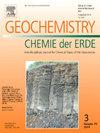Exploring Optical and Geochemical Zoning Variation in Chromite: Metasedimentary vs. Orthomagmatic Origins in Singhbhum Craton, Eastern India
IF 2.9
3区 地球科学
Q2 GEOCHEMISTRY & GEOPHYSICS
引用次数: 0
Abstract
The Banded Chromite-Quartzite (BCQ) deposits of Ghutrigaon, Singhbhum Craton, exhibit a metasedimentary geneology, diverging significantly from the world's well-established orthomagmatic deposits of Sukinda located in the southern fringe of the Singhbhum Craton, Eastern India. This study explores the zoning characteristics of chromite grains from Sukinda and Ghutrigaon in the Singhbhum Craton, revealing insights into their genetic evolution. It aims to elucidate the connection between their development and the physico-chemical changes that occurred during post-protolithic processes. Petrography and mineral chemistry analysis reveal two distinct features i.e., Ghutrigaon chromite displays a brighter core zone and is in sharp contrast with Sukinda chromite grains that show greater marginal reflectivity. The zoning of Ghutrigaon chromite follows an aluminium trend, with a core enrichment of Cr and Fe and a rim concentration of Al and Mg. The iron trend is evident in the zoned chromite of Sukinda, with concentrations of Mg, Al, and Ni dominating at the core, while Cr, Fe, Ti, and Mn are enriched at the periphery. In Ghutrigaon chromite, there is a preferential migration of Mg ions from the core to the altered rim, while trace elements such as Sc, Nb, and U move from rim to core, and Sr, Hf, and Zr increase from core to rim. In contrast, Sukinda chromite experiences leaching of Cr and Fe from the core, with subsequent precipitation in the rim. Trace elements in Sukinda chromite show a decreasing trend for Cu, Sr, Zr, Hf, and La with Mg#, indicating that Mg variations also influence these trace and rare earth elements during alteration. Ghutrigaon chromite likely originated in a Supra-Subduction Zone environment and zoning in its Cr-spinel is attributed to solid-state diffusion during metamorphism. In contrast, the Sukinda chromite is associated with boninitic magma in a back-arc rifting environment and its chromite zoning is the product of secondary changes that occurred during serpentinisation.
印度东部Singhbhum克拉通铬铁矿的光学和地球化学分带变化:变质沉积与正岩浆成因
Singhbhum克拉通Ghutrigaon的带状铬铁矿石英岩(BCQ)矿床具有元沉积谱系,与位于印度东部Singhbhum克拉通南缘的世界知名的Sukinda正岩浆矿床有明显的差异。研究了兴兴克拉通苏达达和古特古冈铬铁矿的分带特征,揭示了它们的成因演化。目的是阐明它们的发育与后原石器时代过程中发生的物理化学变化之间的联系。岩石学和矿物化学分析表明,古特古岗铬铁矿具有较亮的核心带,与苏达达铬铁矿具有较大的边缘反射率形成鲜明对比。古特冈铬铁矿的分带呈铝化趋势,核心富集Cr和Fe,边缘富集Al和Mg。苏金达铬铁矿呈明显的铁化趋势,核心以Mg、Al、Ni为主,外围富集Cr、Fe、Ti、Mn。古特古岗铬铁矿中,Mg离子从岩心向蚀变边缘优先迁移,微量元素Sc、Nb、U从岩心向岩心迁移,Sr、Hf、Zr从岩心向岩心迁移。与此相反,苏达纳铬铁矿经历了Cr和Fe从岩心的浸出,随后在边缘析出。苏达达铬铁矿中微量元素Cu、Sr、Zr、Hf、La随Mg#的变化呈下降趋势,说明在蚀变过程中Mg的变化对这些微量元素和稀土元素也有影响。古特古岗铬铁矿可能起源于超俯冲带环境,其铬尖晶石的分带性主要归因于变质过程中的固态扩散。而苏达纳铬铁矿则与弧后裂陷环境下的辉长质岩浆有关,其铬铁矿分带是蛇纹岩化过程中次生变化的产物。
本文章由计算机程序翻译,如有差异,请以英文原文为准。
求助全文
约1分钟内获得全文
求助全文
来源期刊

Chemie Der Erde-Geochemistry
地学-地球化学与地球物理
CiteScore
7.10
自引率
0.00%
发文量
40
审稿时长
3.0 months
期刊介绍:
GEOCHEMISTRY was founded as Chemie der Erde 1914 in Jena, and, hence, is one of the oldest journals for geochemistry-related topics.
GEOCHEMISTRY (formerly Chemie der Erde / Geochemistry) publishes original research papers, short communications, reviews of selected topics, and high-class invited review articles addressed at broad geosciences audience. Publications dealing with interdisciplinary questions are particularly welcome. Young scientists are especially encouraged to submit their work. Contributions will be published exclusively in English. The journal, through very personalized consultation and its worldwide distribution, offers entry into the world of international scientific communication, and promotes interdisciplinary discussion on chemical problems in a broad spectrum of geosciences.
The following topics are covered by the expertise of the members of the editorial board (see below):
-cosmochemistry, meteoritics-
igneous, metamorphic, and sedimentary petrology-
volcanology-
low & high temperature geochemistry-
experimental - theoretical - field related studies-
mineralogy - crystallography-
environmental geosciences-
archaeometry
 求助内容:
求助内容: 应助结果提醒方式:
应助结果提醒方式:


